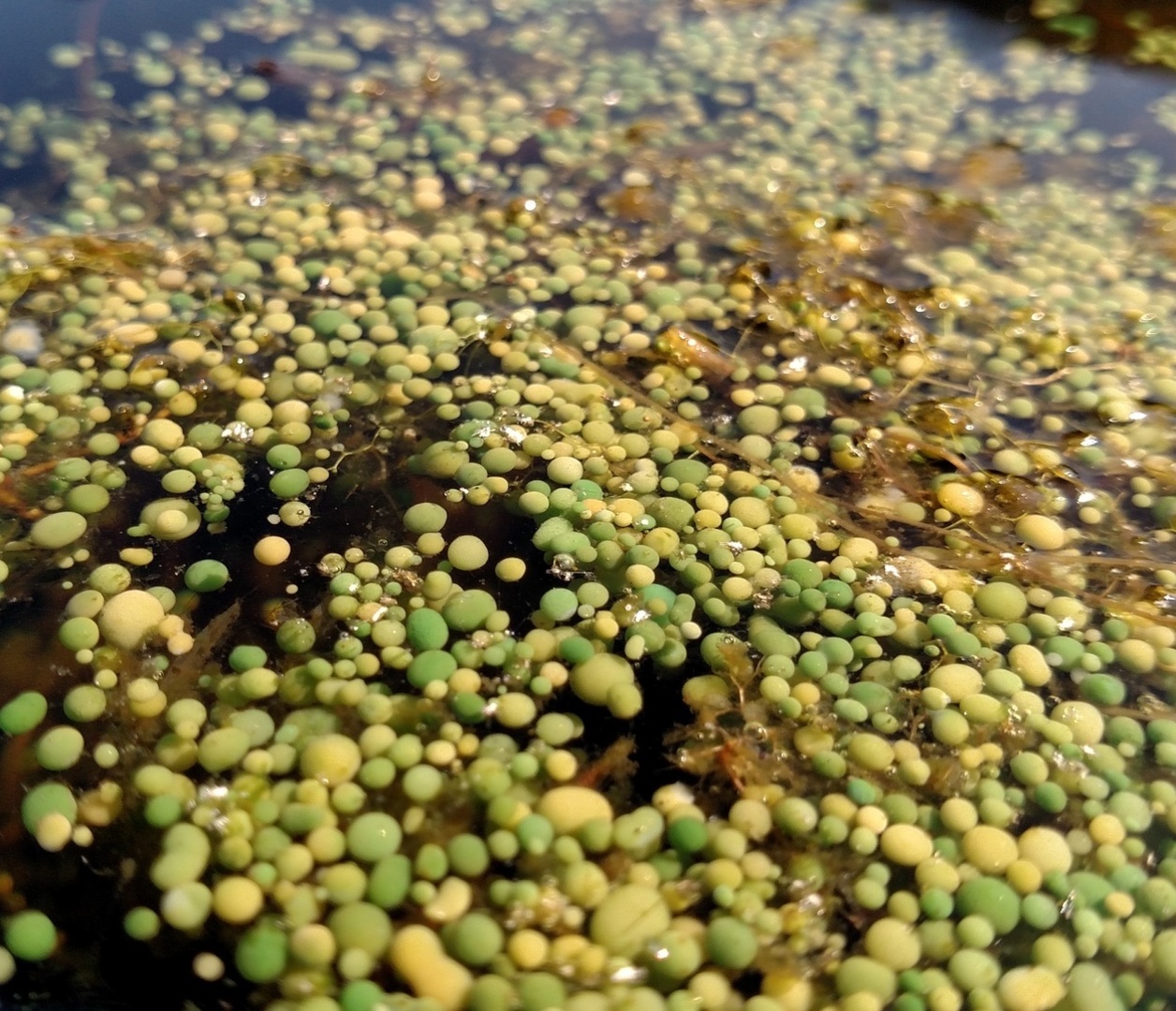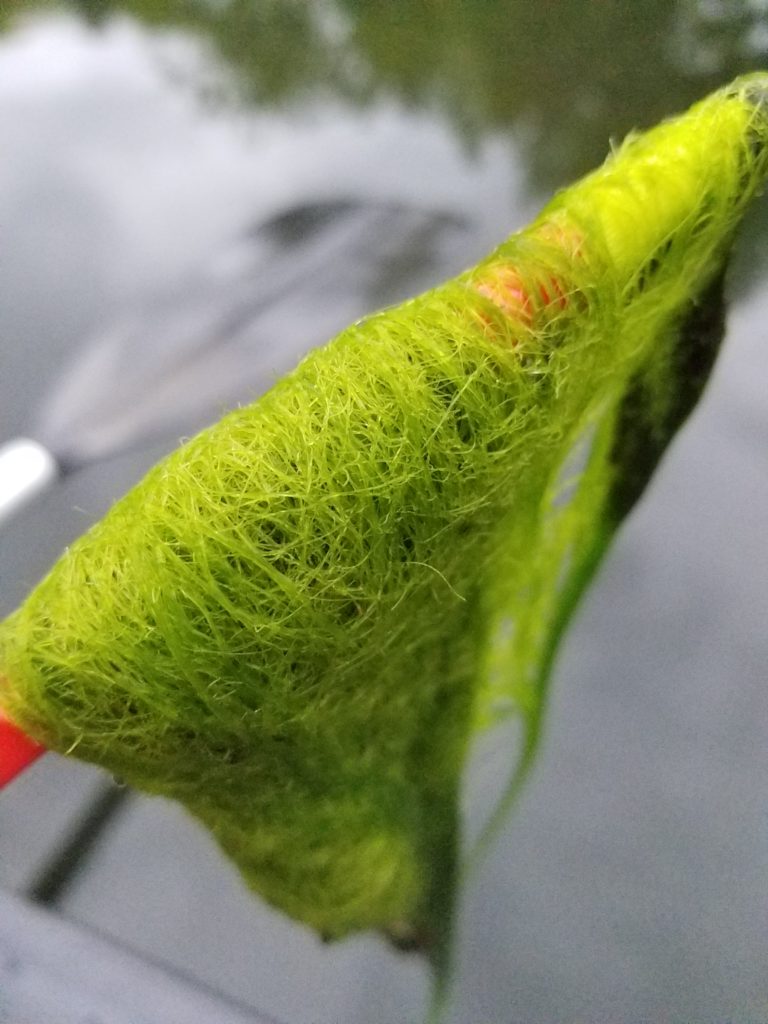

Phytoplankton: Get to Know Your Pond Algae
Phytoplankton, better known as algae, is present in all lakes and ponds, although we generally only become aware of it when it becomes a nuisance. These nasty, smelly filamentous mats on the surface of the water can lead to fishing frustration and reduced aesthetics, and can negatively impact recreational activities like swimming and boating. Nuisance phytoplankton can also be suspended in the water column, often called unicellular blooms. These blooms typically occur later in the season, reducing the water clarity and often giving the water a “pea soup” green appearance. They are usually associated with cyanobacteria (blue-green algae), and can negatively impact water clarity and water chemistry. Cyanobacteria can also be toxic and cause serious health problems for humans and animals.
Lakes and ponds typically contain three broad categories of phytoplankton. These include filamentous phytoplankton, macroscopic multi-branched phytoplankton (which appear similar to submersed plants), and unicellular phytoplankton.

Filamentous phytoplankton are macroscopic (that is, visible with the naked eye) and composed of long chains of cells that are attached to a substrate, which is either the lake bottom, submersed, or emergent vegetation, or rocks. This is called benthic filamentous algae (BFA), and rampant growth can become visible at the surface. As pieces of benthic filamentous algae break apart, it often floats on the surface as dense unsightly mats called floating filamentous algae (FFA). Oftentimes, genera of green algae or blue-green algae develop into nuisance filamentous mats on the surface of lakes and ponds.
Macroscopic multi-branched phytoplankton may look like submersed vegetation, especially when viewed in the water column. Examination reveals simple structures, no conductive tissue, and a lack of roots (instead of having simplified rhizoids). Under the right conditions, this type of phytoplankton can reach lengths of several feet and creates a dense carpet on the bottom of a lake or pond. Therefore, it is not usually seen as a nuisance, save for high-use shallow areas such as beaches and other popular swim areas. Since this phytoplankton occupies a similar ecological niche as submersed plants, it’s often included in detailed and visual aquatic plant surveys. It actually provides some benefits, as it stabilizes sediment, acts as a nutrient sink, provides invertebrate and fish habitat, and is one of the first macrophytes to re-colonize a disturbed area.
Unicellular phytoplankton go through a seasonal succession. In other words, certain groups occur at greater abundances at different times of the year, depending on a complex array of environmental factors. These factors can include physical (such as water flow, wind, or basin morphology), chemical (nutrient loading), or biological (such as feeding pressure) attributes of a basin.
The following is a summary of the six most common groups of unicellular phytoplankton that occur in freshwater systems.
Diatoms
Diatoms are ubiquitous as a group, and often possess a rigid silica shell with ornate cell wall markings or etchings. The silica shells settle to the bottom substrate after they die, and can become stratified. Limnologists can then study historical (and possibly even ancient) population characteristics of diatoms. Some are round and cylindrical (centric) in shape, while others are long and wing-shaped (pennales). They are usually brown in color, and reach maximum abundance in colder (winter or early spring) or acidic water.
Golden Algae
Golden Algae are typically yellow or light brown in color. Cell size is usually small oval-shaped with a partially empty area, but several genera create colonies of smaller cells. Most have two flagella, and some type of scales or a rigid coating that grants it a fuzzy appearance. However, a few filamentous forms are possible as well. They typically prefer cooler water, so they dominate in the late fall, winter, or early spring and occasionally bloom at deeper (cooler) depths. They are common in low nutrient water, and numerous forms produce taste and odor compounds.
Green Algae
Green Algae are a very diverse group of unicellular phytoplankton. There is tremendous variability in this group which varies from family to family and sometimes even genus to genus. There are flagellated single cells, multi-cell colonies (some motile), filamentous and attached forms, typically with distinct cell shapes and light green in color. Some prefer acidic waters, and others highly eutrophic conditions. A green algae bloom usually occurs in water with high nitrogen levels. Green algae typically dominate during the summer months of the year.
Cyanobacteria
Cyanobacteria (Blue-green algae) tend to be small, simple in structure and lacking interior cell details, often encased in a mucilaginous outer layer. Some genera are adorned with heterocysts, swollen structures capable of fixing nitrogen, a competitive advantage. These types tend to bloom in nitrogen-poor or eutrophic systems. Yet, cyanobacteria are tolerant of a wide variety of water chemistries, and boast many oligotrophic forms as well. Cyanobacteria often have gas vesicles which provide increased buoyancy, which is another competitive advantage over other groups of phytoplankton, due to their propensity to shade out others by blooming at the surface. Numerous cyanobacteria are documented taste and odor producers, and under certain environmental conditions and high enough densities, can produce toxins dangerous to fish, livestock, and possibly humans. Cyanobacteria typically dominate a lake or pond system in late summer to early fall.
Euglenoids
Euglenoids are usually motile with between zero and three flagella, one of which is longer. Euglenoids have highly variable shape (plasticity) and are grass green in color, although sometimes they are clear or even red. Most forms have a distinct red “eyespot.” They are often associated with high organic content water and eutrophic conditions.
Dinoflagellates
Dinoflagellates are very common in marine environments, in which they produce toxic blooms. However, toxin production in freshwater genera is very rare. Dinoflagellates are typically single ovoid to spherical cells, but large compared to phytoplankton from other groups. They usually possess two flagella (one wrapped around the middle of the cell) which grant them rotation while they move through the water column. Cellulose plates (armored dinoflagellates) are more common, but genera without cellulose plates (naked dinoflagellates) also occur. They generally prefer organic-rich or acidic waters, and can impart a coffee-like brown tint to the water at high enough densities.
If issues arise with algae in your lake or pond, it is recommended to contact a professional aquatic manager to help evaluate and identify the species. Proper identification is the first step to creating an effective treatment plan as part of a comprehensive lake and pond management program.
Contact the experts at 888-480-5253 for your lake, pond and fisheries management needs.
SOLitude Lake Management is an environmental firm committed to providing full-service solutions that improve water quality, preserve natural resources, and reduce our environmental footprint. Our services include lake, pond, wetland, and fisheries management programs, algae and aquatic weed control, mechanical harvesting, hydro-raking, installation and maintenance of fountains and aeration systems, water quality testing and restoration, bathymetry, lake vegetation studies, biological assessments, habitat assessments, invasive species management and nuisance wildlife management. Services, consulting, and aquatic products are available to clients nationwide, including homeowners associations, multi-family and apartment communities, golf courses, commercial developments, ranches, private landowners, reservoirs, recreational and public lakes, municipalities, parks, and state and federal agencies. Learn more about SOLitude Lake Management and purchase products at www.solitudelakemanagement.com









